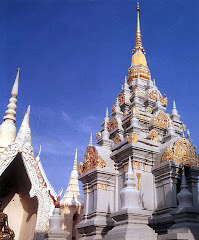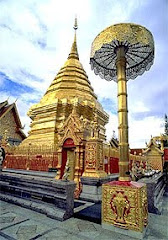
This is a royal temple of the Dhammayut Sect in the northeast. The temple, built in 1853 on the bank of the Mun River surrounded by beautiful and tranquil scenery. There is a Thai-Chinese-European style ordination hall, which houses the principal serene Buddha image of the temple.
photo: thai-tour
Related Tags: Wat Supattanaram/Ubon Ratchathani,/thai temple/Wat thai/temple
Friday, August 24, 2007
Wat Supattanaram : Ubon Ratchathani
Posted by
myplot'blog
at
9:24 PM
0
comments
![]()
Labels: temple, thai temple, Ubon Ratchathani, Wat Supattanaram, wat thai
Wat Nong Bua : Ubon Ratchathani
 This is the only temple in this province that has a rectangular Chedi, which is an imitation of Chedi Buddhakhaya of India. The temple is located on the outskirts of Ubon Ratchathani on Highway No. 212 (Ubon-Amnat Charoen). At the 3-km. marker on the highway, turn into a side road and proceed for 800 meters to the temple.
This is the only temple in this province that has a rectangular Chedi, which is an imitation of Chedi Buddhakhaya of India. The temple is located on the outskirts of Ubon Ratchathani on Highway No. 212 (Ubon-Amnat Charoen). At the 3-km. marker on the highway, turn into a side road and proceed for 800 meters to the temple.
Related Tags: Wat Nong Bua/Ubon Ratchathani/thai temple/Thai Chedi/temple/Buddhakhaya
Posted by
myplot'blog
at
9:08 PM
0
comments
![]()
Labels: Chedi, temple, thai temple, Ubon Ratchathani, Wat Nong Bua
Wat Nong Pah Pong : Ubon Ratchathani
Wat Nong Pa Phong is a mediation center with a quiet and peaceful atmosphere where a number of foreigners practice Buddhism. The center is located on Highway No. 2178 about 6 kilometers from the city.
Wat Nong Pa Phong and Wat Pa Nanachat, provide a special opportunity for non-Thai speakers to find out more about Buddhism and to experience the insight meditation (Vipassana-style of meditation). For those interested, it is recommended that you can pay a visit to the temple of your choice and discuss with foreign monks beforehand. The participation in the meditation course may require some commitments. Call Wat Nong Pa Phong at tel. 045 322729 for more information. Staff speaks English.
Necessities to take with you when staying in Buddhist temple/monastery/retreat Centre:
The following items are suggested as useful to take:
- Clothes:Loose fitting, easily cared for. Simple sandals and some loss fitting tops, especially T-shirts are highly recommended. An umbrella can be useful in the rainy season. In the cold season a sweater or two would be practical. Also a blanket or sleeping bag.
- Medicine:Pills for diarrhea and constipation, mosquito repellent and coils, tiger balm or other ointment for bites. Some kind of antibiotic or disinfectant for cuts, band-aids, minor first-aid stuff. Eye wash can be very useful. Anti-malaria preventives.
- Food items:Most of the temples/monasteries provide both food and accommodation. However, there are some useful items you might bring along but not necessary: thermos, coffee, tea, sugar, milk, ovaltine, hot plate, cup and kettle.
- Toilet articles:Toilet paper, soap, mirror, all toilet articles. Helpful to have a small scrub brush for laundry.
- Tips: Behave with full awareness, dress conservatively, have much patience to yourself and others.
source:tourismthailand
Related Tags: Wat Nong Pah Pong/Ubon Ratchathani,/thai temple/Thailand temple/temple
Posted by
myplot'blog
at
8:49 PM
0
comments
![]()
Labels: temple, thai temple, Ubon Ratchatani, Wat Nong Pah Pong, wat thai
Tuesday, August 14, 2007
Wat Neramit Wipattasana : Loei

 The temple is located on a hillside near Phra That Si Song Rak. Both the ordination hall and pagoda, which are constructed of laterite, were designed from the imagination of both monks and novices. On touring the interior visitors will notice a resemblance to the great temples of Bangkok. Other than a replica of Phra Phutthachinnarat (of Phitsanulok Province) that is enshrined here, there is a wax figure of the late Luang Pho Phra Maha Phan Sila Wisuttho, the founder of the temple.
The temple is located on a hillside near Phra That Si Song Rak. Both the ordination hall and pagoda, which are constructed of laterite, were designed from the imagination of both monks and novices. On touring the interior visitors will notice a resemblance to the great temples of Bangkok. Other than a replica of Phra Phutthachinnarat (of Phitsanulok Province) that is enshrined here, there is a wax figure of the late Luang Pho Phra Maha Phan Sila Wisuttho, the founder of the temple.
photo:moohin
Related Tags: Wat Neramit Wipattasana/Loei /Wat/Temple/thai temple
Posted by
myplot'blog
at
6:38 AM
0
comments
![]()
Labels: Loei, thai temple, wat, Wat Neramit Wipattasana, wat thai
Monday, August 6, 2007
Prathat Tha Uthen : Nakhon Phanom

Phra That Tha Uthen is located opposite Hin Bun town in Laos. It is situated approximately 26 kilometers north of the city on Highway 212. Similar in style to Phra That Phanom, Phra That Tha Uthen is 66 meters high. Constructed in 1912, the chedi (pagoda) houses the relics of the Lord Buddha’s disciple brought from over from Yangon, Myanmar.
[source:thai-tour.com]
Related Tags: Pra That/Phra That Tha Uthen/Nakhon Phanom/Chedi/thai temple/wat
Posted by
myplot'blog
at
10:03 PM
0
comments
![]()
Labels: Nakhon Pathom, Phathat Tha Uten, Prathat
PRASAT NANG RAM : Nakorn Ratchasima province

Prasat Nang Ram is located 79 kilometers far from town on the route No. 2 It can be reached by driving 62 kilometers to the crossroads of Ban Wat, then turing right along the highway No. 207 for 22 kms. To Ban Nang Ram and finally turining left with travelling further for 4 kilometers. Prasat Nang Ram was built in Khmer style during the 12th century to be a nursing place.
The sanctuary consists of the main stupa an vihara surrounded by laterite walls. Outside the wall, there is a pond lined with stepped laterite. Far away 80 meters, surrounded by leterite walls and the U-shaped pond are other three stupas assumed to be the residence of medical men.
Related Tags: Prasat Nang Ram/Nakorn Ratchasima/Prasat/ancient ruins
Posted by
myplot'blog
at
9:44 PM
0
comments
![]()
Labels: ancient ruins, Nakhon Ratchasima, Prasat, Prasat Nang Ram









